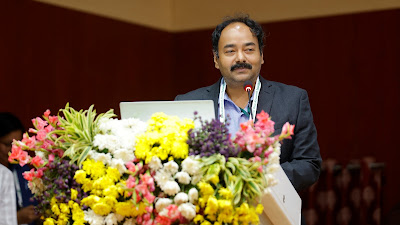Hyderabad, India (April 29, 2025) – In a bid to strengthen regional collaboration, IRRI hosted its annual advancement meeting with partners in South Asia at the ICAR -Indian Institute of Rice Research (ICAR-IIRR), Rajendranagar. The event brought together over 100 rice researchers and partners to discuss breeding innovations and recalibrate priorities for the upcoming seasons.
Several key achievements were highlighted during the meeting. Dr. Vikas Kumar Singh, IRRI’s Regional Breeding Lead for South Asia, emphasized the need for joint breeding strategies with national partners, outlining recent steps that the partnership has taken such as launching medium and short slender breeding programs and setting up crossing blocks at partner institutions.
In his update, Dr. Sankalp Bhosale, Interim Research Director and Head of IRRI’s Rice Breeding Innovation, spoke about the steady expansion of the South Asia breeding network. He pointed to improvements in genetic gains and productivity since the network’s establishment six years ago.
 |
| Dr. RM Sundaram, Director, ICAR-IIRR, in his opening message, highlighted the importance of a balanced approach in shaping the future of regional rice research. |
These milestones were acknowledged by Dr. RM Sundaram, Director of ICAR-IIRR, by calling for a balanced breeding approach that addresses both short- and long-term needs, especially those linked to climate and pest challenges. He noted that most solutions should come from genetics and breeding, with the rest from agronomy and protection research. Lastly, he affirmed that the meeting would shape a clear roadmap for regional rice research.
In his opening message, Dr. Sudhanshu Singh, Director of the IRRI South Asia Regional Centre (ISARC) talked about the expanded breeding collaboration beyond India, including the South Asian Association for Regional Cooperation (SAARC) Nations. Furthermore, he highlighted the potential of Seed Without Borders agreements to accelerate the release of new rice varieties across countries.
'These new breeding lines and varieties have the potential to extend beyond our current horizons, with India or the region positioning itself as a global leader in the future. This opportunity could very well extend beyond South Asia,” he said.
Following the opening discussions, IRRI scientists and national partners shared key updates on breeding progress and innovations to advance climate-resilient, high-yielding rice varieties in South Asia
Progress in Accelerating Breeding for High-Yield, Climate-Resilient Rice
The meeting highlighted key innovations in rice breeding aimed at increasing productivity, enhancing climate resilience, and accelerating varietal adoption in South Asia. A major focus was on developing high-yield Direct Seeded Rice (DSR) lines using Rapid Cycle Recurrent Selection, with trials in Eastern India showing that DEMS-R (Medium Slender Soft) varieties can produce up to 6.4 tons per hectare. Additionally, the launch of the NARES-IRRI Product Advancement Dashboard was announced, which will provide real-time updates on the progress of new rice varieties, streamlining decision-making. The introduction of a medium slender grain (MS Grain) pipeline to the TMESFI program was also discussed, aimed at improving data collection for future breeding cycles and enhancing selection performance.
Advances in climate-resilient rice breeding were another focal point. Varieties such as FR13A, BR11 Sub1, and CR 1009 Sub1, which exhibit strong flood tolerance, were highlighted. Research across 10 million hectares showed that some of these varieties can withstand up to 21 days of submersion, addressing the challenges faced by regions vulnerable to flooding. In parallel, the integration of seed systems with breeding efforts to accelerate varietal adoption was discussed, with new varieties like CR Dhan 320 and DRR Dhan 323 showing good results in Eastern India, and varieties such as DRR Dhan 53 and Ratnagiri 8 gaining traction in Odisha. A digital portal is being developed to track varietal adoption and speed up the dissemination of these new varieties
Breeding innovations were supported by advances in new tools and approaches. The Zinc 5 (Zn5) QTL, which increases grain zinc content without reducing yield, was highlighted, along with tools like HaploGUI and the 4K-8K HaploPanel, which allow for more precise identification of haplotypes linked to important traits like yield and disease resistance.
Finally, collaborative efforts also extended to the establishment of a centralized seed multiplication system and joint research initiatives focusing on salinity tolerance, including a proposed joint crossing block for saline-prone areas.
Collaboration for Better Rice Science
 |
| Dr. Singh, in his closing message, emphasized the strength of the IRRI-NARES partnership and expressed gratitude to the ICAR-IIRR team |
Dr. Singh reaffirmed the strength of the IRRI-NARES partnership, “through close collaboration, we can ensure that our efforts in breeding and seed systems translate into real-world benefits."
The South Asia Advancement Meeting was co-organized by IRRI’s Rice Breeding Innovation team and National Breeding Network partners (ICAR-IIRR), representing breeding leads across various pipelines and market segments.
###
Learn more about IRRI (www.irri.org) or follow us on social media and networks (all links down the right column).


No comments:
Post a Comment